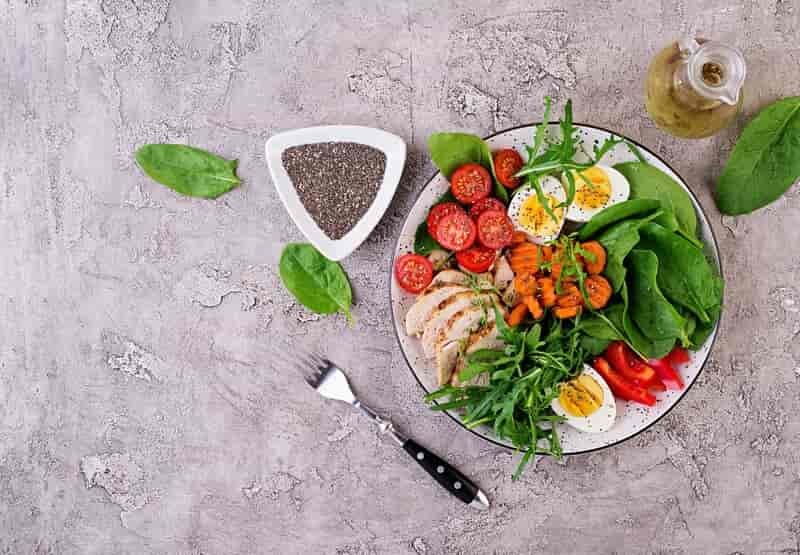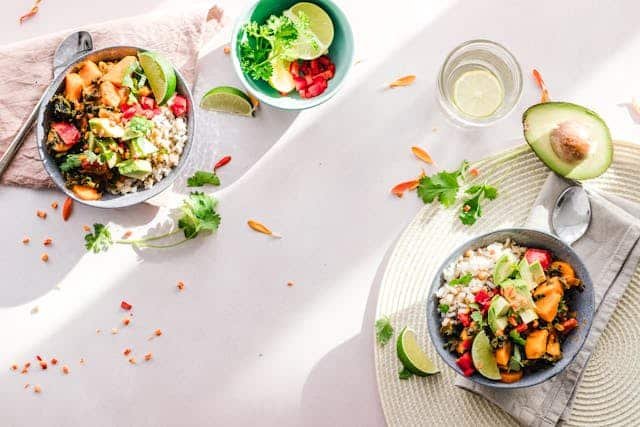In This Article
- 1. Introduction to the keto diet and its focus on low-carb meals
- 2. Benefits of Incorporating Salads into a Keto Diet
- 3. Basic components of a keto-friendly salad (low-carb vegetables, healthy fats, protein sources)
- 4. Tasty and Nutritious Keto Salad Recipe Ideas
- 5. Tips for dressing a keto salad (avoiding high-carb dressings, using homemade vinaigrettes)
- 6. Importance of portion control and monitoring carb intake even in salads
- 7. Conclusion emphasizing the versatility and health benefits of keto salads.
- Frequently Asked Questions (FAQ)
1. Introduction to the keto diet and its focus on low-carb meals
The keto diet, which stands for ketogenic diet, is a low-carb, high-fat eating plan aimed at getting your body into a state called ketosis. In this state, your body becomes good at burning fat for energy rather than relying on carbs. To reach ketosis, you must cut your carbohydrate intake to about 20-50 grams daily and replace those calories with fat.
The heart of the keto diet lies in focusing on low-carb meals. When you limit carbs, your body uses up its glycogen stores, which are the primary energy source from carbohydrates. Once these stores run low, your liver turns fats into ketones, providing an alternative energy source for your brain and body. This metabolic shift can promote fat loss and offer additional health perks like better blood sugar regulation, decreased hunger, and improved mental clarity.
A typical meal on the keto diet Salad features high-fat foods such as avocados, nuts, seeds, olive oil, and fatty cuts of meat while minimizing high-carb foods like bread, pasta, and sugary snacks. This approach encourages eating nutrient-dense whole foods, helping people meet their nutritional needs while adhering to low-carb guidelines.
In summary, the keto diet emphasizes changing the balance of macronutrients to support weight loss and metabolic health. Those following this diet must plan their meals carefully, ensuring they stay within their carb limits while enjoying tasty and satisfying dishes.
2. Benefits of Incorporating Salads into a Keto Diet
Adding salads to a keto diet brings many benefits that fit perfectly with the low-carb principles of this eating plan. Below are several key advantages:
- Low in Carbs: Salads are generally low in carbohydrates, making them an excellent option for those on a ketogenic diet. By using leafy greens, various vegetables, and healthy fats, salads help maintain the right macronutrient balance needed for ketosis.
- High in Nutrients: Salads can contain nutrient-packed ingredients like spinach, kale, arugula, and other non-starchy veggies. These greens are full of vitamins, minerals, and antioxidants, vital for overall health, particularly when limiting carbs.
- Fiber-Rich: Salads’ veggies and other ingredients provide dietary fiber that encourages good digestive health. While some people might be concerned about getting enough fiber on a keto diet, adding salads can help maintain adequate fiber levels, promoting regularity and gut wellness.
- Versatile and Customizable: You can easily tailor salads to fit your tastes and dietary needs. The options are endless: add grilled chicken or salmon for protein or toss in cheese, nuts, and avocado for healthy fats. This adaptability keeps meals exciting and satisfying.
- Hydration: Many salad ingredients, like cucumbers and tomatoes, contain a lot of water, which helps with hydration. Staying hydrated on a keto diet is crucial since eating fewer carbs can lead to more water loss.
- Supports Satiety: Including healthy fats like olive oil, avocado, or nuts in salads can boost your fullness and help manage hunger. This can be particularly helpful for those trying to control their appetite while following a restrictive diet.
- Easy Meal Prep: Salads can be made ahead of time, making them a convenient choice for busy people. Preparing large batches of salads allows quick, grab-and-go meals that seamlessly fit into a keto lifestyle.
- Encourages Healthy Eating Habits: Regularly eating salads promotes healthier eating overall. It enables a mindset focused on consuming more whole foods and nutrient-dense ingredients, which is great for long-term health.
3. Basic components of a keto-friendly salad (low-carb vegetables, healthy fats, protein sources)
A keto-friendly salad is crafted to fit the principles of a ketogenic diet, which focuses on consuming low carbohydrates while boosting healthy fats and proteins. Here’s a detailed overview of the essential components:
- Low-Carb Vegetables: These form the base of your salad, offering essential nutrients while keeping carbs low. Great options include leafy greens like spinach, kale, arugula, cucumbers, zucchini, bell peppers, and broccoli. They’re low in carbohydrates but high in fiber, which is excellent for digestion.
- Healthy Fats: To ensure your salad is truly keto-friendly, including healthy fats is essential. You can add ingredients like avocados, olive oil, nuts (such as almonds or walnuts), seeds (like chia or flaxseeds), and cheeses (like feta or mozzarella). These fats help you feel full and provide critical fatty acids that support overall health.
- Protein Sources: Incorporating protein into your salad is crucial for maintaining muscle and overall energy levels. Good protein choices include grilled chicken, turkey, hard-boiled eggs, bacon, or plant-based options like tofu or tempeh. Protein helps with satiety and meets your body’s nutritional needs.
Mixing these elements—low-carb vegetables, healthy fats, and protein sources—will create a satisfying and nutrient-rich salad that aligns perfectly with a ketogenic lifestyle.
4. Tasty and Nutritious Keto Salad Recipe Ideas
Salads are a fantastic way to include healthy fats and low-carb ingredients while keeping your meals exciting and satisfying if you’re on a ketogenic diet. Here are some tasty and nutritious keto salad recipes to try:
Avocado Chicken Bacon Salad
This hearty salad combines grilled chicken, crispy bacon, and creamy avocado, all mixed with fresh greens. The chicken protein and the avocado’s fats make it a filling choice that fits perfectly within keto guidelines. Drizzling it with a light olive oil dressing enhances the flavor without adding any carbs.
Greek Salad with Feta and Olives
A classic Greek salad can easily fit into a keto diet by focusing on low-carb ingredients. This version features fresh cucumbers, juicy tomatoes, red onions, and kalamata olives, all topped with crumbled feta cheese. To keep it keto-friendly, use a dressing made with olive oil and lemon juice. The rich flavors of feta and olives create a satisfying taste while keeping the carb count low.
Salmon Avocado Cucumber Salad
This refreshing salad mixes flaky cooked salmon, creamy avocado, and crunchy cucumber for a delightful balance of textures. Salmon is an excellent source of omega-3 fatty acids, which are beneficial for heart health. Toss everything with a squeeze of lemon and a dill sprinkle for an extra flavor. This dish is nutritious and packed with protein and healthy fats.
Spinach and Mushroom Salad with Balsamic Vinaigrette
A spinach and mushroom salad drizzled with balsamic vinaigrette is a light yet flavorful option. Sautéed mushrooms contribute an earthy taste, while fresh spinach contains vitamins and minerals. The balsamic vinaigrette adds sweetness without overwhelming the salad with carbs, making it a delightful addition to any keto meal plan.
These salad ideas are keto-friendly and rich in nutrients, making them excellent choices for anyone looking to maintain a healthy lifestyle while enjoying delicious meals.
5. Tips for dressing a keto salad (avoiding high-carb dressings, using homemade vinaigrettes)
When dressing a keto salad, selecting dressings that stick to the low-carb principles of the ketogenic diet is crucial. Here are some helpful tips to create the perfect keto-friendly salad dressing:
- Steer Clear of High-Carb Dressings: Many store-bought dressings are loaded with sugar and high-carb ingredients that can throw off your keto goals. Common offenders include ranch dressing, barbecue sauce, and certain vinaigrettes. Always read the nutritional labels for hidden sugars and carbohydrate counts to ensure they fit your daily limits.
- Make Your Vinaigrettes: Whipping up your salad dressing is a fantastic way to control the ingredients and keep it keto-friendly. A simple vinaigrette can be created using olive oil, vinegar (like balsamic, apple cider, or red wine), and your favorite herbs and spices. For a basic recipe, mix three parts olive oil with 1 part vinegar, then add salt, pepper, and any extra flavors you like, such as garlic or mustard.
- Try Healthy Fats: Since the keto diet emphasizes healthy fats, think about using ingredients like avocado oil, sesame oil, or coconut oil in your dressings. These oils add a delicious flavor and bring in the healthy fats that are key to a keto lifestyle.
- Add Low-Carb Flavor Enhancers: To make your homemade dressings even tastier, consider adding ingredients like lemon juice, fresh herbs, or low-carb condiments such as mustard or hot sauce. These additions can boost the flavor without piling on unnecessary carbs.
- Balance Your Ingredients: When putting together your salad, make sure your dressing complements the other elements. For instance, if your salad is packed with hearty greens, nuts, and cheese, a more decadent dressing like a creamy avocado or ranch base can be satisfying. On the other hand, a lighter vinaigrette might be just suitable for a salad filled with delicate greens and fresh veggies.
By following these tips, you can whip up delicious and satisfying keto salads that help you stick to your low-carb lifestyle while enjoying a range of flavors and textures.
6. Importance of portion control and monitoring carb intake even in salads
To maintain a balanced diet, paying attention to portion sizes and carbohydrate intake is essential, even when eating seemingly healthy options like salads.
- Understanding Portion Control: Portion control means being aware of how much food we eat at one time. It’s critical to patenting overeating, which can lead to weight gain and health problems. Even healthy foods can add up in calories if we don’t manage our don’t sizes adequately.
- The Carb Content in Salads: While salads are often seen as low in carbs, many ingredients can significantly increase the carb count. Dressings, croutons, and certain vegetables like corn and peas can add more carbs than expected. Even fruits like apples or grapes can introduce additional sugars into your meal.
- Balancing Macronutrients: By keeping track of the carbs in salads, you can better balance your intake of macronutrients—ensuring you get enough protein, healthy fats, and carbohydrates. This balance is crucial for maintaining energy levels, feeling full, and supporting overall health.
- Mindful Eating: Consistency of portion sizes and carb content promotes mindful eating, which helps develop a healthier relationship with food. It encourages you to make more informed choices about what foods to combine and how much to eat.
- Weight Management: To manage your weight or blood sugar levels, controlling portion sizes and carb intake is essential. By being careful about what you add to your salad, you can enjoy your meals without jeopardizing your health goals.
In summary, while salads can be a great addition to your diet, practicing portion control and monitoring carbohydrate intake is crucial to ensure they support your overall balanced diet.
7. Conclusion emphasizing the versatility and health benefits of keto salads.
Keto salads are a nutritious and flexible choice for anyone on a ketogenic diet. They typically include low-carb ingredients high in healthy fats, making them perfect for promoting ketosis, where the body uses fat for energy instead of carbs.
One significant advantage of keto salads is their versatility; you can easily customize them to match your taste and dietary requirements. Feel free to combine leafy greens like spinach, kale, or romaine with various low-carb veggies such as cucumbers, bell peppers, and avocados. Adding protein sources like grilled chicken, crispy bacon, or hard-boiled eggs boosts the flavor and makes the salad more filling, making it a complete meal.
Additionally, keto salads are loaded with essential nutrients. The colorful mix of vegetables provides vital vitamins and minerals for overall health. At the same time, the healthy fats from ingredients like olive oil, avocado, and nuts contribute to heart health and help you feel satisfied for longer.
Adding keto salads to your meals helps you achieve your dietary goals. It allows you to enjoy a delightful array of flavors and textures while benefiting from a low-carb lifestyle.
Frequently Asked Questions (FAQ)
What makes a salad keto-friendly?
A salad that is considered keto-friendly is low in carbohydrates and high in healthy fats, which is the cornerstone of the ketogenic diet. Typically, it will consist of various leafy greens, an assortment of non-starchy vegetables, and dressings approved for keto consumption to ensure you stay within your carb limits.
Can I include fruits in my keto salad?
Yes, you can include fruits in your keto salad, but it’s essential to be mindful of both the type of fruit and the quantity you use. Low-carb fruits such as berries can be a delightful addition when used in moderation, while it’s best to avoid high-sit fruits that could disrupt your carb intake.
Is store-bought salad dressing safe for keto?
Not necessarily. Many commercially available salad dressings contain added sugars and high-carb ingredients that can easily throw off your keto diet. It’s essential to carefulIt’sead the labels and select dressings that align with your keto guidelines to stay on track.
How can I add protein to my keto salad?
There are several delicious ways to add protein to your keto salad. Consider incorporating grilled chicken, succulent shrimp, hard-boiled eggs, crispy bacon, or tofu, as these are all excellent sources of protein that will help make your salad more filling and nutritious.
Are all vegetables suitable for keto salads?
Unfortunately, not all vegetables are suitable for keto salads due to their carb content. It’s wise to focus on lowIt’sb options like leafy greens, fresh cucumbers, vibrant bell peppers, and zucchini to ensure your salads fit the keto framework.
What type of oil should I use for my vinaigrette?
It’s best to use healthy ingredients when making a vinaigrette for your keto salad. Options such as olive oil, avocado oil, or coconut oil are optimal choices that enhance the flavor and provide the healthy fats needed for a keto diet.
How can I enhance the flavor of my salad without adding carbs?
You can boost the flavor of your salad without significantly increasing the carb count by using a variety of herbs and spices. Additionally, lemon juice or low-carb condiments like mustard or vinegar can add a zesty kick to your dish while keeping it keto-friendly.
Is portion control still necessary with keto salads?
Absolutely! Practicing portion control is still essential, even when enjoying healthy foods like salads. This practice helps prevent overeating and assists with managing caloric intake, ensuring you stay within your dietary goals.
Can I meal prep keto salads?
Definitely! Meal-prepping keto salads can save you significant time during the week. Store the dressing separately from the salad components to maintain freshness and prevent sogginess.
How can I ensure my keto salad is balanced?
To create a well-balanced keto salad, aim for a harmonious mix of healthy fats, quality protein, and a variety of low-carb vegetables. This combination will satisfy your hunger and provide a nutritious and balanced meal.
Are there any quick keto salad recipes available?
Yes, there are plenty of quick and easy keto salad recipes that you can whip up in no time. These recipes often combine simple ingredients like leafy greens, grilled proteins, and a flavorful homemade dressing for a nutritious and delicious meal that fits perfectly into your keto lifestyle.

Ruby
Ruby is a certified fitness coach and trainer dedicated to helping individuals achieve their health and fitness goals. Specializing in personalized workout plans, Ruby provides expert guidance and motivation to clients of all fitness levels. Her energetic and supportive approach ensures effective, safe, and enjoyable training experiences.







